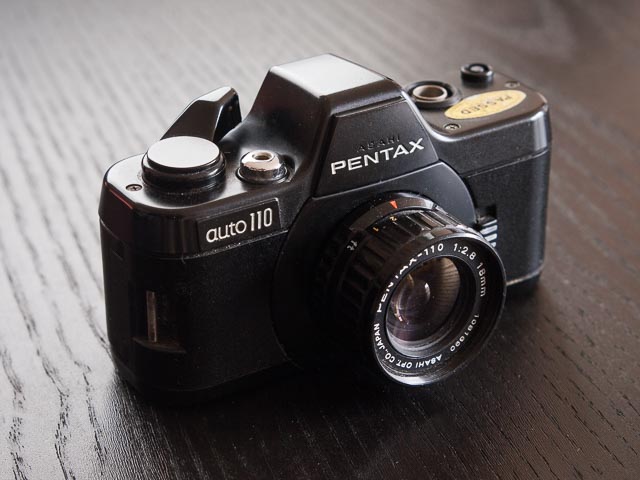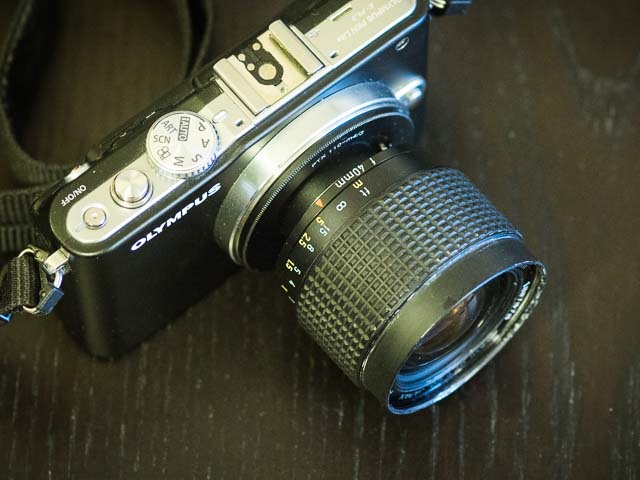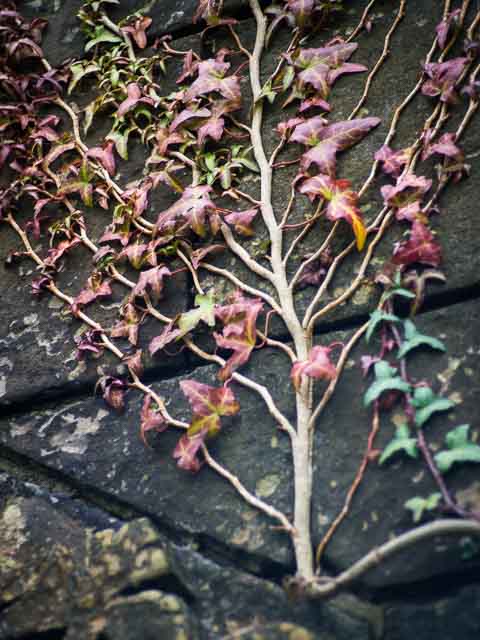Pentax Auto 110

The late 1970's was the hey day of sophisticated 110 cameras, and when Pentax launched it's Auto 110 system in 1978 it was at the top of the tree. It was the only 110 camera to offer a full system of lenses, filters, and other accessories. It is a very elegant little camera and a remarkable feat of miniaturisation offering proper through-the-lens viewing and metering, just like a full size 35mm SLR. All this in a camera weighing just 172 grams!
The only problem was that when you added the flash unit, autowinder and zoom lens the result was a rather ungainly 600 grams or so. Within a few years of the Auto 110's introduction 35mm compact cameras offering all those features built-in and weighing less than half that were commonly available.
But the despite its undoubted elegance and sophistication, it's very difficult to see just who the Auto 110 was aimed at. It was really a point and shoot camera with completely automatic programmed exposure. Yet the sort of user who wants such a camera is unlikely to want to faff around with changing lenses. And the sort of user who enjoys that sort of thing is likely to want some way of controlling the exposure settings.
Furthermore the inherent limitations of the 110 format meant this camera never really produced the results its engineering (and price) suggested it was capable of. Today the Auto 110 is mainly interesting as a remarkable feat of miniaturisation and an aesthetically elegant design.
In order to keep the lens designs as simple as possible Pentax built all the lenses with no aperture diaphragm. Instead there is a combined shutter/diaphragm mechanism in the camera. This means that the shutter has to remain open during viewing, but a light tight mirror box protects the film from fogging.
In 1983, towards the end of the Auto 110's production, the Auto 110 Super was introduced with a number of improvements, including a backlight compensation button, a self-timer and a single stroke film advance (rather than double stroke advance on the original Auto 110. The original system consisted of 18mm, 24mm and 50mm lenses (approximately 35mm, 50mm and 100mm 35mm equivalents) AF130P and the smaller AF100P flash guns and the Autowinder. Fairly late in Auto 110 production a 70mm, 20-40mm zoom and 18mm fixed focus lenses were introduced along with an updated autowinder for the Super that included continuous film advance of 1.5 frames per second. Because the Super and the 3 later lenses were late introductions they are rare and sought after.
| Type: | TTL metering 110 SLR camera with bayonet mount for interchangeable lenses |
|---|---|
| Film type: | Cartridge-loading 110 film |
| Negative format: | 13mm x 17mm |
| Lens: | Pentax-110 24mm f/2.8; 47 degree angle of view; 25.5mm filter thread. focusing range: 0.35mm-infinty |
| Viewfinder: | Eye-level pentaprism finder with quick-return mirror |
| focusing: | Central splt-image focusing spot surrounded by matte field |
| Viewfinder information: | Green LED indicates adequate shutter speed (minimum of 1/30 sec. at f/2.8); yellow LED indicates slow shutter speed (less than 1/30 sec.) requiring use of tripod or auto flash to avoid camera shake. Magnification: 0.75X showing 87% of the picture area |
| Battery check: | Viewfinder LED fails to light on depressing shutter button when batteries are low |
| Exposure meter: | Center-weighted, TTL metering at full aperture via SPD cell. EV range 3-17 (24mm f/2.8 lens; 100ASA) |
| Film speed setting: | Automatic set for available 110 films |
| Shutter: | Programmed electronic behind-the-lens shutter |
| Shutter-speed/aperture range: | 1/750 sec. at f/13.5 - 1 sec. at f/2.8 |
| Film advance: | Two 145 degree strokes of ilm advance lever advance film a single frame; 60 degree pre-advance setting |
| Exposure counter: | Frame number appears in back cover winder |
| Other features: | Sync terminal for automatic flash sync with AF130P or AF10P auto flash unit at 1/40 sec. (f/2.8); tripod socket; lens release button, wrist strap hook, battery holder tray, winder capability. |
| Power source: | Two 1.5v Alkaline (LR44) or Silver-oxide (G13) batteries |
| Size with standard lens: | 56mm x 99mm x 45mm |
| Size without lens: | 56mm x 99mm x 32mm |
| Weight with standard lens: | 172 grams |
| Weight without lens: | 159 grams |
My Pentax Auto 110 system
Pentax-110 24mm f/2.8
Equivalent to 50mm on a 35mm camera. This lens weighs a mere 13 grams!!


Pentax-110 18mm f/2.8
Equivalent to 35mm on a 35mm camera.


Pentax-110 50mm f/2.8
Equivalent to 100mm on a 35mm camera.


Pentax-110 20-40mm f/2.8
Equivalent to 40-80mm on a 35mm camera. This lens is also shown mounted on an Olympus Pen E-PL3 digital camera using an adapter.




Pentax-110 AF-100P
This was the smaller of two flashguns produced for the Auto 110 system. The AF-130P was larger and more powerful


Photographs taken with Pentax Auto 110 lenses
These days you can’t really take pictures with the 110 cameras. The film is very difficult to come by, and finding someone to develop and print it even harder. Lomography have recently introduced some brand new 110 cameras and are selling film to go with them, but that doesn’t answer the problem of getting your picture developed and printed.
And there is another problem: no 110 camera has any way to set the ISO rating of the film. Instead the original specification for the 110 film standard provided for 2 film speeds, defined by Kodak simply as ‘high’ and low’ (with the low speed treated as 80ASA and the high speed treated as 400ASA by most cameras, including the Pentax Auto 110). Each of these two film speeds had a different shaped tab at the end that cameras were supposed to detect to set the film speed automatically. The problem is that modern 110 film is generally available in 400ASA and sometimes 200ASA, and they all use the tab shape that in the past signified low speed film.
This is of no consequence for most recent 110 cameras since they are all simple plastic boxes with fixed apertures and shutter speeds, but the Pentax Auto 110 has a sophisticated exposure system and all modern films will be treated as 80ASA film! But there is a way around this: you can just make sure you use 400ASA film and then trim the tab to match the shape of the tab that used to signify high speed film.
But there is a way to continue taking photographs with these lenses: M4/3 compact system cameras are great for using with a wide variety of legacy glass using adapters that can be bought very cheaply on eBay (other auction sites are available!) And because 110 film produces negatives 17x13mm, which just happens to be exactly the same size as a M4/3 sensor. So Pentax Auto 110 lenses are ideal candidates for use on M4/3 as you're using the lenses in their original scope of use. Well, almost ideal… because the lenses don’t have an the aperture diaphragm you're always shooting at the maximum aperture (which is f/2.8 for all Pentax Auto 110 lenses.)
The quality of these lenses at f/2.8 is a bit dire, especially away from the image centre… anyone keen on 100% pixel peeping turn away now! But I never-the-less rather like the way these lenses render a scene. And I've always thought that sharpness is perhaps the least important characteristic of a lens in determining what the photograph will actually look like in real world situations. Anyway… take a look and decide for yourself :-)





